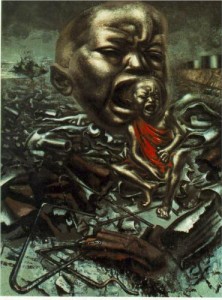A History of Acrylic Painting

Acrylic painting is a relatively modern medium in painting. Acrylic offers versatility, immediacy, and durability. Acrylic is known for producing bright colors, sharp lines, can be used on various surfaces, and it can be mixed with other media. It gives artists different approaches to express one’s creativity.
Here is a brief history of acrylic painting:
1901
In 1901, a well-known German chemist, Dr. Otto Rohm developed the first synthetic acrylic resin. He published his dissertation on the polymerization products of acrylic acids. Rohm secured in 1915 a patent for polyacrylic ester as a paint binder used in drying oils in industrial paints and lacquers. Initially intended for industrial use, acrylics caught the attention of artists due to its features: quick drying, adheres to any surface, even sheen, and no base coat necessary.
1920s-1930s
Mexican muralists explored these synthetic mediums and experimented with acrylic paints. In 1936, David Alfaro Siqueiros, a Mexican muralist founded a workshop in New York City to experiment with acrylics and its different methods of applications. He used acrylics in his famous painting, Echo of a Scream, in 1937. Jackson Pollock attended Siquerios’ workshop and later used synthetic gloss enamel paints in his art which uses dripping and pouring techniques.
1940s
Acrylics were made available to modern painters. Leonard Bocour and Sam Golden offered mineral spirit-based paints called Magna. Well-known artists including Barrett Newman and Mark Rothko experimented with acrylics in painting.
1950s
Rohm and Otto Haas introduced the first acrylic emulsion specifically designed for paints. It became the foundation for all contemporary artists’ acrylic emulsions. By 1955, water-based acrylic paints were made available commercially on the market.
1960s
UK art supplier George Rowney first introduced the brand “Cryla,” and artist’s acrylic color.
20th century
Acrylics became the center of modern art movements and form. This is the time when artists were exploring pop culture, photorealism, abstract expressionism, and pop art. American artists such as Andy Warhol and Helen Frankenthaler were attracted to acrylics since it provided an ideal medium for these movements. Acrylics provided artists limtless artistic expression and creativity. Artists can achieve different textures, consistencies, and color depths.
Image source: www.wikipaintings.org